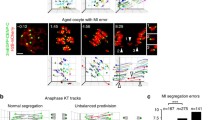Abstract
The incidence of univalents was compared between slides prepared according to two clearly different chromosomal methods, i.e. Tarkowski's method and ours, in order to examine whether a univalent pair could be formed artifactually at the first meiotic metaphase (MI). The oocytes used were obtained from young (2–3 months) and old (12–15 months) age groups of both C57BL/6 and dd mice. In Tarkowski's method only a single fixative was used, while in our method three different fixatives were used successively in order to fix oocytes without their being ruptured. Despiralized, fuzzy and loosely associated chromatids were seen frequently in the slides prepared by Tarkowski's method, while such features were seen less frequently in the slides prepared by our method. The incidence of oocytes with univalents in the slides made by Tarkowski's method was much higher than in those made by ours in both age and strain groups (P<0.05–0.001). Thus, it was confirmed that the so-called univalents could be produced artifactually. The results did not support the production line hypothesis of Henderson and Edwards (1968) which was based on their observation of an increased incidence of univalents in MI oocytes from aged female mice.
Similar content being viewed by others
References
Boer P de, Van der Hoeven FA (1980) The use of translocation derived “marker-bivalents” for studying the origin of meiotic instability in female mice. Cytogenet Cell Genet 26:49–58
Bond DJ, Chandley AC (1983) Aneuploidy. Oxford monographs on medical genetics. no. 11. Oxford University Press, Oxford
Funaki K, Mikamo K (1980) Giant diploid oocytes as a cause of digynic triploidy in mammals. Cytogenet Cell Genet 28:158–168
Henderson SA, Edwards RG (1968) Chiasma frequency and maternal age in mammals. Nature 218:22–28
Kamiguchi Y, Funaki K, Mikamo K (1976) A new technique for chromosome study of murine oocytes. Proc Jpn Acad 52:316–319
Kanda N, Kato H (1980) Analysis of crossing over in mouse meiotic cells by BrdU labelling technique. Chromosoma 78:113–121
Luthardt FW, Palmer CG, Yu P-L (1973) Chiasma and univalent frequencies in ageing female mice. Cytogenet Cell Genet 12:68–79
Martin RH, Dill FJ, Miller JR (1976) Non-disjunction in aging female mice. Cytogenet Cell Genet 17:150–160
Mikamo K (1982) Meiotic chromosomal radiosensitivity in primary oocytes of the Chinese hamster. Cytogenet Cell Genet 33:88–94
Mikamo K, Kamiguchi Y (1983a) A new assessment system for chromosomal mutagenicity using oocytes and early zygotes of the Chinese hamster. In: Ishihara T, Sasaki MS(eds) Radiation-induced chromosome damage in man. Alan R Liss Inc, New York, pp 411–431
Mikamo K, Kamiguchi Y (1983b) Primary incidences of spontaneous chromosomal anomalies and their origins and causal mechanisms in the Chinese hamster. Mutat Res 108:265–278
Polani PE, Jagiello GM (1976) Chiasmata, meiotic univalents, and age in relation to aneuploid imbalance in mice. Cytogenet Cell Genet 16:505–529
Speed RM (1977) The effects of ageing on the meiotic chromosomes of male and female mice. Chromosoma 64:241–254
Speed RM (1982) Meiosis in the foetal mouse ovary. I. An analysis at the light microscope level using surface-spreading. Chromosoma 85:427–437
Speed RM, Chandley AC (1983) Meiosis in the foetal mouse ovary. II. Oocyte development and age-related aneuploidy. Does a production line exist? Chromosoma 88:184–189
Sugawara S, Mikamo K (1980) An experimental approach to the analysis of mechanisms of meiotic nondisjunction and anaphase lagging in primary oocytes. Cytogenet Cell Genet 28:251–264
Sugawara S, Mikamo K (1983) Absence of correlation between univalent formation and meiotic nondisjunction in aged female Chinese hamsters. Cytogenet Cell Genet 35:34–40
Tarkowski AK (1966) An air-drying method for chromosome preparation from mouse eggs. Cytogenetics 5:394–400
Author information
Authors and Affiliations
Rights and permissions
About this article
Cite this article
Sugawara, S., Mikamo, K. Maternal ageing and nondisjunction: A comparative study of two chromosomal techniques on the formation of univalents in first meiotic metaphase oocytes of the mouse. Chromosoma 93, 321–325 (1986). https://doi.org/10.1007/BF00327590
Received:
Revised:
Issue Date:
DOI: https://doi.org/10.1007/BF00327590




